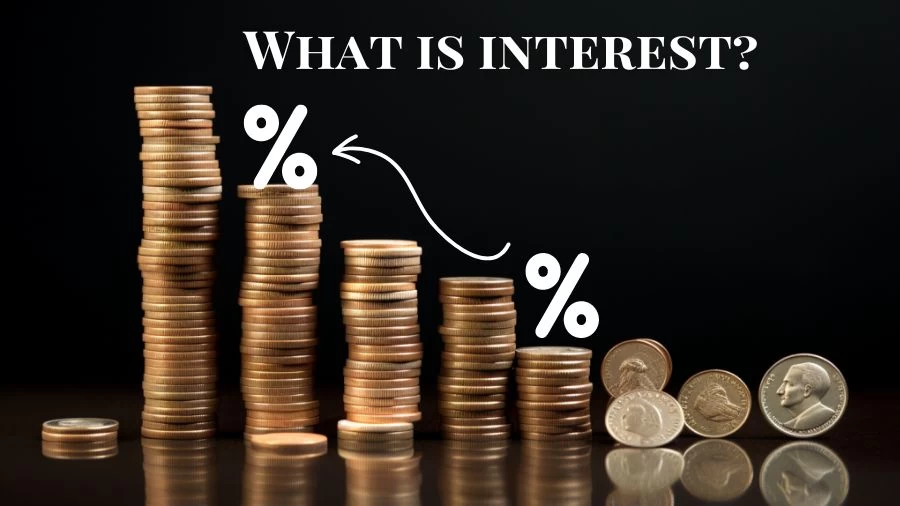
What is Interest? How Does Interest Work?
Interest is a fundamental financial concept, denoting the cost of borrowing money expressed as an APR. Lenders earn interest, and borrowers pay for using funds, categorized as simple or compound.
by Sangamithra
Published Aug 31, 2023 | Updated Aug 31, 2023 | 📖 9 min read
On This Page
- What is Interest?
- How Does Interest Work?
- What is Interest Rate?
- Why is It Called Interest?
- What is the Interest Payment?
- Interest Vs Interest Rate
- What Are the Different Types of Interest Rate?
- What Are the Common Applications of Interest?
- What Are the Advantages and Disadvantages of Paying Interest?
What is Interest?
Interest is a fundamental financial concept, representing the cost or compensation for borrowing money. It's commonly expressed as an annual percentage rate (APR), denoting the monetary charge for borrowing funds. Lenders earn interest by lending money, while borrowers pay it for using those funds.
Interest can be categorized as simple interest, based solely on the principal amount, or compound interest, factoring in both the principal and previously accumulated interest. It finds applications in credit cards, mortgages, loans, and savings accounts.
The history of interest rates traces back to ancient civilizations, and its acceptance evolved over time. Interest rates are influenced by macroeconomic policies, such as the Federal Reserve's decisions. Overall, interest plays a pivotal role in both personal finance and broader economic dynamics.
How Does Interest Work?
Interest is a fundamental concept in finance, elucidated by the text. It's the cost of borrowing money, adding to the initial loan amount. Different loans, such as mortgages, credit cards, and car loans, bear varying interest rates based on factors like loan type, term length, and borrower creditworthiness. When borrowing $100 at a 5% interest rate, for instance, you pay back $105, leaving the lender with a $5 profit.
An Annual Percentage Rate (APR) encompasses the interest and additional fees over a year. The Federal Reserve's influence on interest rates is highlighted, with higher rates encouraging spending in good economic times and vice versa. In savings accounts, interest is earned as an incentive for depositing money. This succinctly captures how interest shapes financial transactions and the economy.
What is Interest Rate?
An interest rate is the cost of borrowing money and is a fundamental element in financial transactions. When you borrow funds, the lender charges interest, which represents the additional amount you need to repay beyond the borrowed sum. Interest rates impact various aspects of personal finance, such as loans for homes, cars, and credit cards.
These rates are diverse due to factors like the type of loan, repayment schedule, creditworthiness, and market conditions. The Annual Percentage Rate (APR) encompasses not just the interest rate but also associated fees. For instance, mortgages are influenced by economic trends and credit history, while credit cards bear higher rates due to their unsecured nature.
The Federal Reserve sets central bank rates, affecting the broader lending landscape. Savings accounts also yield interest, though at a lower rate. Understanding interest rates is vital for effective financial management and decision-making.
Why is It Called Interest?
The term "interest" in the context of finance and borrowing has its origins in Latin and Old French. The word "interest" comes from the Latin word "interest," which means "it interests" or "it concerns." In Old French, "interest" was derived from "interesse," which also meant "to interest" or "to concern."
The concept of interest in financial transactions evolved from the idea that when someone lends money, they have a stake or concern in the borrower's financial affairs. Lenders expect compensation for allowing borrowers to use their funds, which is where the notion of "interest" as a payment for the use of money originated.
Over time, this concept became an integral part of financial systems, where lenders are compensated for the time value of money – the idea that a sum of money available today is worth more than the same amount in the future due to its potential earning capacity or investment opportunities. As a result, the term "interest" has persisted to refer to the cost of borrowing or the earnings generated from lending money in various financial transactions.
What is the Interest Payment?
An interest payment is the additional cost incurred when borrowing money. Apart from repaying the loan principal, borrowers make regular interest payments, which compensate lenders for the borrowed funds. Interest payments are determined by an agreed-upon annual interest rate at the initiation of the loan. While they usually remain constant, certain loans, termed "variable interest" loans, see changing rates.
For instance, if you borrow $1,000 with a 3% annual interest rate to be repaid in a year, you'd owe $30 in interest payments, alongside the principal. These payments signify the expense of borrowing, aiding lenders in earning beyond the principal amount lent.
Interest Vs Interest Rate
Interest and interest rate are related financial concepts, but they have distinct meanings. Interest refers to the additional cost incurred when borrowing money or the earnings gained from lending money. It's the price paid for using someone else's funds. On the other hand, the interest rate is the percentage at which interest is calculated.
It represents the cost of borrowing or the return earned on an investment. The interest rate determines how much interest will be paid or earned over a specific period. It's a crucial factor in various financial transactions, including loans, savings accounts, bonds, and mortgages. In summary, interest is the actual amount of money paid or earned, while the interest rate is the percentage used to calculate that amount.
What Are the Different Types of Interest Rate?
Interest rates are crucial components of financial transactions, representing the cost of borrowing money or the return on lending. There are two primary types of interest rates: simple interest rates and compound interest rates.
1. Simple Interest Rate:
Simple interest is calculated only on the principal amount of a loan or investment. It doesn't take into account any interest that accumulates over time. For instance, if you borrow $300,000 at a 4% simple interest rate for a year, you'll pay back $312,000 at the end of the year, as the interest is calculated solely on the initial amount.
2. Compound Interest Rate:
Compound interest is more complex as it considers not only the principal but also the accumulated interest from previous periods. This means that interest is earned or charged on both the initial amount and the interest that has already accrued. Compound interest is used in various financial products like savings accounts and loans. For example, with a $300,000 loan at a 4% compound interest rate over 30 years, you could end up owing almost $700,000 due to the compounding effect.
What Are the Common Applications of Interest?
Interest plays a pivotal role in various aspects of personal finance and the broader economy. It is a fundamental concept that influences borrowing, lending, and investment decisions. Here are some common applications of interest in different financial contexts:
Credit Cards: Credit cards are known for having relatively high annual percentage rates (APRs), resulting in the accumulation of substantial interest for borrowers who carry balances from month to month. When consumers make minimum payments on their credit card balances, the unpaid portion accrues interest, adding to the overall debt. Interest earned from credit card balances benefits credit card providers and financial institutions.
Mortgages: Mortgages involve long-term loans used to purchase homes. Over the life of a mortgage, borrowers make monthly payments that include both principal repayment and interest. While interest rates can be fixed or variable, they contribute to the overall cost of the home purchase. As borrowers pay down the principal, the interest portion of their payments decreases, helping them build equity in their homes.
Auto Loans: Auto loans allow individuals to purchase vehicles by spreading out the cost over a fixed period. Lenders charge interest on auto loans, often as a fixed rate. Auto dealerships and financing departments benefit from the interest revenue generated by these loans.
Student Loans: Student loans enable individuals to invest in education and skill development. These loans can accrue interest over time, affecting the overall repayment amount. During specific periods, such as the COVID-19 pandemic, interest on student loans might be temporarily paused to ease financial burdens for borrowers.
Savings Accounts: While interest is often associated with borrowing, it also benefits savers. Savings accounts with banks and financial institutions provide an opportunity for individuals to earn interest on their deposited funds. This interest, also referred to as dividends, contributes to the growth of savings over time.
Invoices: In the business world, interest can also be applied to outstanding invoices. Some companies choose to charge interest on late payments to incentivize timely settlement. This practice acknowledges the opportunity cost of lending funds to the debtor and encourages prompt payment.
Investments: Investors can earn interest through various investment vehicles, such as bonds and certificates of deposit (CDs). When investors purchase bonds, they essentially lend money to the issuer in exchange for periodic interest payments and eventual return of the principal amount. CDs also offer fixed interest rates to investors over a predetermined term.
What Are the Advantages and Disadvantages of Paying Interest?
Advantages of Paying Interest:
- Relatively Low Expense: Paying interest is often a relatively low-cost option compared to alternatives. For instance, it might be more financially viable to pay interest on a loan for essential needs like reliable transportation, rather than trying to buy an entire car outright.
- Building Credit History: Paying interest means holding debt and making regular payments. This contributes positively to your credit history, which is essential for obtaining favorable terms on future loans and credit.
- Effective Use of Leverage: Paying interest can be a strategic use of leverage. Real estate developers, for example, often borrow money to construct and rent buildings. If the rate of return on the property is higher than the interest rate on the loan, they are essentially using borrowed money to make a profit.
Disadvantages of Paying Interest:
- Recurring Cash Expense: Paying interest means committing to a regular cash outlay. Monthly payments are typically applied to interest assessments before reducing the principal amount of the debt. This can sometimes become a financial burden.
- Potential Overwhelming Debt: Accumulating too many loans with high monthly payments can lead to overwhelming debt. High interest payments can restrict your financial flexibility and ability to take on more credit or invest.
- Contractual Obligation: Paying interest implies a contractual obligation to repay borrowed money along with the interest. This obligation can be restrictive, especially if your financial situation changes and you're unable to make timely payments.
- Compound Interest Effect: Compound interest, especially for borrowers, can lead to a significant increase in the total amount owed over time. Borrowers might find that their monthly payments increase due to accumulated interest being added to the principal balance.
- Risk of Default: In situations of high debt and limited financial resources, paying interest can increase the risk of defaulting on payments. Defaulting not only harms your credit history but might also result in the loss of collateral, such as a house or car.
- Limitation on Borrowing Capacity: If a significant portion of your income is dedicated to paying interest, your ability to take on additional credit, such as for a home mortgage or a business loan, might be compromised.
What is Interest - FAQs
1. What is the difference between simple and compound interest?
Simple interest is calculated solely on the initial loan amount, while compound interest includes both the principal and accumulated interest from previous periods.
2. How do interest rates affect mortgages?
Interest rates impact mortgage payments; higher rates increase the cost of borrowing, while lower rates reduce monthly payments.
3. Why is having a good credit history important for interest rates?
A good credit history leads to lower interest rates, as lenders view borrowers as less risky and more likely to make payments on time.
4. Can interest payments on loans be tax- deductible?
Yes, in some cases, interest payments on certain types of loans, such as mortgage or student loans, can be tax-deductible, reducing the borrower's taxable income.
5. How does the Federal Reserve influence interest rates?
The Federal Reserve's decisions on central bank rates affect overall interest rates in the economy; higher rates discourage borrowing and spending, while lower rates stimulate economic activity.




